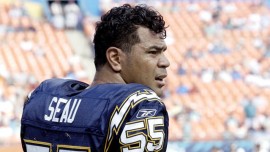Football Brain Injuries
An estimated 300,000 sports related traumatic brain injuries, TBIs, of mild to moderate severity, most of which can be classified as concussions, occur in the United States each year. The proportion of these concussions that are repeat injuries is unknown; however, there is an increased risk for subsequent TBI among persons who have had at least one previous TBI. Repeated mild brain injuries occurring over an extended period can be catastrophic or fatal.
Football has been a rough sport since the leather-helmet days, but today’s version raises the violence to an art form. No other contact sport gives rise to as many serious brain injuries as football does. High school football players alone suffer 43,000 to 67,000 concussions per year, though the true incidence is likely much higher, as more than 50% of concussed athletes are suspected of failing to report their symptoms.
The human brain, although encased by a heavy-duty cranium, isn’t designed for football. Helmets do a nice job of protecting the exterior of the head and preventing deadly skull fractures. But concussions occur within the cranium, when the brain bangs against the skull. When helmets clash, the head decelerates instantly, yet the brain can lurch forward, like a driver who jams the brakes on. The bruising and stretching of tissue can result in something as minimal as “seeing stars” and a momentary separation from consciousness.
Repeated blows to the head, which are routine in football, can have lifelong repercussions. A study commissioned by the NFL found that ex–pro players over age 50 were five times as likely as the national population to receive a memory-related-disease diagnosis. Players 30 to 49 were 19 times as likely to be debilitated. Some scientists now fear that the thousands of lower-impact, or “subconcussive,” blows these players receive, even if they don’t result in documented concussions, can be just as damaging as — if not more so than — the dramatic head injuries that tend to receive more attention and intensive treatment.
A 2000 study that surveyed 1,090 former NFL players found that more than 60 percent had suffered at least one concussion during their career. And a study commissioned by the NFL in 2009 reported that former NFL players have been diagnosed with Alzheimer’s disease or other memory problems 19 times more than the normal rate for men between 30 and 49. And pathologists who have examined the brains of ex-athletes have found signs of chronic traumatic encephalopathy (CTE), a progressive neurological disease that patients get after sustaining repeated head injuries. It is characterized by the build up of a toxin protein called tau in the form of neurofibrillary tangles (NFTs) and neuropil threads (NTs) throughout the brain. The abnormal protein initially impairs the normal functioning of the brain and eventually kills brain cells. Early on, CTE sufferers may display clinical symptoms such as memory impairment, emotional instability, erratic behavior, depression and problems with impulse control. However, CTE eventually progresses to full-blown dementia.
Second Impact Syndrome
Second impact syndrome, or SIS, occurs when an athlete returns to sport too early after suffering from an initial concussion. The athlete does not need to receive a strong second blow to the head to set the effects in motion. The athlete may receive only a minor blow to the head or a hit to the chest or back that snaps the head enough to have the brain rebound inside the skull.
The risk for second impact syndrome should be considered in a variety of sports associated with likelihood of blows to the head, including football. Neurologists say once a person suffers a concussion, he is as much as four times more likely to sustain a second one. Moreover, after several concussions, it takes less of a blow to cause the injury and requires more time to recover. NFL player, Troy Aikman, sustained 8 concussions that he publicly admits to, the last two occurred since January 1, 2000.
Brain Injury Information
- Anatomy of the Brain
- Brain Injury Glossary
- Brain Injury Prevention
- Brain Injury Statistics
- Children’s Brain Injuries
- Common Causes of TBI
- Concussion Checklist
- Effects of Brain Injury
- Emotional Changes Associated with Brain Injury
- Financial Costs of Brain Injuries
- Football Brain Injuries
- Recovery from Traumatic Brain Injury (TBI)
- Symptoms of Brain Injury
- TBI Frequently Asked Questions
- Treatment for TBI
- What is Traumatic Brain Injury?
- What To Do After a Concussion

